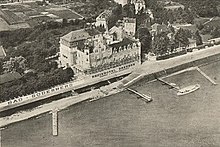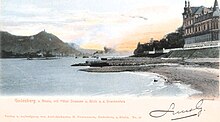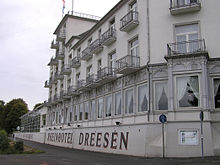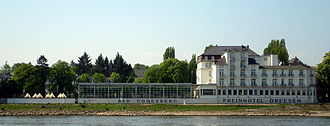Rheinhotel Dreesen
The Rheinhotel Dreesen is a hotel in Rüngsdorf , part of the Bad Godesberg district of Bonn , which was built at the end of the 19th century. The large building stands out due to its imposing facade with Art Nouveau elements on the Bad Godesberg Rhine promenade and is a renowned accommodation due to its location, its historical importance and its numerous prominent guests. It is still run by the old Dreesen family from Rüngsdorf.
location
The hotel is located below the Rüngsdorf town center between the banks of the Rhine ( John-J.-McCloy -Ufer) and Rheinstrasse (address: Rheinstrasse 45-49).
history
The hotel was created by converting a former summer restaurant on the banks of the Rhine in 1893/94 according to plans by the local builder Georg Westen (1851–1921) for the hotel's founder Friedrich Dreesen (1858–1912). On August 16, 1894, he received the business license for the new company. The long-established family, who came to Rüngsdorf around 1770 and had previously made a living from agriculture, had been active in this trade since the middle of the 18th century. In 1900 the hotel was expanded in a second construction phase.
The Rheinhotel Dreesen advertised early on with modern standards, special music events and the location on the Rhine and tried to set itself apart from the big Godesberg competitors "Hotel Kaiserhof" and " Godesberger Hof ". The hotel's reputation grew and attracted guests such as Crown Prince Wilhelm and Reich Presidents Friedrich Ebert and Paul von Hindenburg . The hotel was able to withstand the difficult economic times of the 1920s and numerous flood damage and accommodated famous personalities such as Gustav Stresemann , Walter Rathenau , Charlie Chaplin , Hans Albers , Greta Garbo and Marlene Dietrich . In 1925 the hotel underwent extensive renovations based on plans by the architect Christoph Brüggemann.
On his first visit to the hotel in 1926, Adolf Hitler signed up as a “stateless writer” and then returned frequently. On June 29, 1934, Hitler met with Joseph Goebbels and Sepp Dietrich in preparation for the Röhm putsch . In September 1938, he moved the negotiations to clarify the Sudeten question with British Prime Minister Neville Chamberlain to the Dreesen Hotel. The hotel owner at the time was considered a “ half-Jew ” in the sense of Nazi ideology and had a Jewish sister-in-law and numerous Jewish friends, but was able to continue operating his hotel unmolested. According to an informant for the American journalist Nora Waln , who was quartered in the hotel in the summer of 1934 immediately after Hitler, the owner at the time was "a childhood friend of the Führer". In 1934 the 2000 m² terrace ("Kastaniengarten") was provided with an electrically adjustable glass roof, which was unique at the time, under the direction of the local architect Willy Maß . At the beginning of the war in 1939, the hotel was confiscated by the German armed forces and served as the headquarters of the Army High Command under General Fedor von Bock . In February 1943, while the hotel continued to operate, it was initially used as temporary accommodation for South and Central American diplomats under the French Vichy regime and, after their departure in 1944/45, mainly for French officers; During this time it functioned from April 1944 at the latest under the cover name Winzerstube as an external command of the Buchenwald concentration camp and was under military guard.
General Richard Schimpf moved into the hotel in March 1945 and handed Godesberg over to the American troops the next day. The hotel then became the quarters of the American commander in chief and later President of the United States , Dwight D. Eisenhower . After July 1945, the confiscated hotel was used by the British troops as a rest home for the Royal Air Force and, from November 1946, for a short time to the Belgian armed forces . From December 1946 it served as accommodation for displaced persons , to relieve the catastrophic housing situation in Godesberg. After Bonn had become the seat of government of the newly founded Federal Republic of Germany in 1949 , the Rheinhotel Dreesen was initially intended as the headquarters of all three high commissions of the occupying powers ( France , USA and Great Britain ), which together formed the Allied High Commission based on the Petersberg . At the beginning of July 1949, the federal capital office of the state of North Rhine-Westphalia received the order to convert the hotel with 110 office rooms on an area of 3320 m² for this purpose - on July 15, the confiscation took place. Half of the 363 refugees housed here were evacuated to Niederbreisig by the end of July . On September 10, the conversion and renovation of the hotel was completed, which, contrary to previous plans, served exclusively as the seat of the French high commission under André François-Poncet - the first to start work in the Bonn area.
In September 1952, after the construction of two rear office buildings (later the French embassy ), the hotel was reopened and on November 17, 1952 it was reopened. The Rheinhotel Dreesen housed numerous diplomats in the first decade of resumption before most states opened an official embassy in the Federal Republic of Germany with their own residence - including the Iraqi embassy for the time being in 1954 . The hotel is now part of the Ringhotels hotel cooperation .
literature
- Jürgen Ehlert: The Dreesen. 100 years of history and stories in the Rheinhotel. Köllen-Druck, Bonn 1994.
- Rüngsdorf. Between towpath and villa district. (Festschrift for the 1200th anniversary) 2004, pp. 65–72.
- Friedrich Georg Wendl: Adolf Hitler's “favorite hotel” belonged to “half-Jews” - 70 years ago, the course for the “Munich Agreement” was set in the Rheinhotel Dreesen . In: Godesberger Heimatblätter: Annual issue of the Association for Home Care and Home History Bad Godesberg eV , ISSN 0436-1024 , Issue 46 (2008), Association for Home Care and Home History Bad Godesberg , Bad Godesberg 2009, pp. 101-108.
- Volker Koop: In Hitler's hands. Special prisoners and honorary prisoners of the SS. Böhlau Verlag, Vienna 2010, ISBN 978-3-412-20580-5 .
Web links
- Official website of the Rheinhotel Dreesen
Individual evidence
- ^ Horst Heidermann : 100 years of the German Werkbund: Godesberg traces . In: Godesberger Heimatblätter: Annual issue of the Association for Home Care and Local History Bad Godesberg eV , ISSN 0436-1024 , Issue 44/2006, pp. 77–119 (here: p. 91).
- ↑ Nora Waln: Reaching for the Stars: My Years in Germany . Stuttgart: Hans E. Günther Verlag, 1948, p. 26
- ^ Norbert Schloßmacher : Buchenwald on the Rhine. Marie-Agnès Cailliau de Gaulle as a prisoner in an external unit of the Buchenwald concentration camp . In: Rheinische Vierteljahrsblätter , ISSN 0035-4473 , volume 71 (2007), pp. 231-253. ( online )
- ^ Helmut Vogt : Rhineland-Palatinate, neighbor of the young federal capital. In: Bonner Geschichtsblätter , Volume 49/50, 1999/2000 (2001), ISSN 0068-0052 , pp. 501-502.
- ↑ a b Helmut Vogt : Guardian of the Bonn Republic. The Allied High Commissioners 1949–1955 , Verlag Ferdinand Schöningh, Paderborn 2004, ISBN 3-506-70139-8 .
- ↑ Diplomatic and other official foreign missions as well as representations of international organizations in the Federal Republic of Germany (as of March 1, 1954). In: Federal Ministry of Finance (Ed.): Bulletin of the Press and Information Office of the Federal Government. Deutscher Bundes-Verlag, 1954, p. 382 ff.
- ^ Michael Wenzel: Small stories Bad Godesberger Messages , 2nd edition 2011, p. 33.
Coordinates: 50 ° 41 ′ 1.4 ″ N , 7 ° 10 ′ 32.5 ″ E






